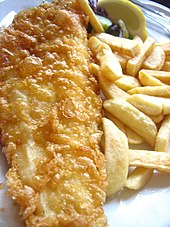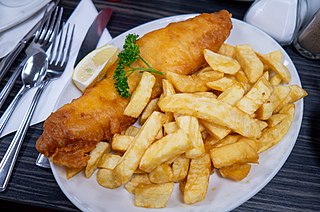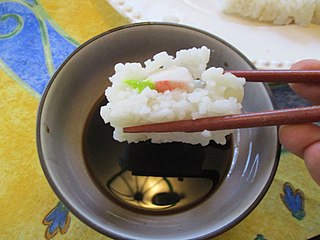

Lekkerbekje is a Dutch fried fish dish. It is sometimes called the Dutch version of fish and chips. [1]


Lekkerbekje is a Dutch fried fish dish. It is sometimes called the Dutch version of fish and chips. [1]
Lekkerbekje is a diminutive of lekkerbek meaning gourmand. [2]
Lekkerbekje consists of a fish fried in batter and deep fried similar to fish and chips. [4]
Originally Lekkerbekje only used whiting, however now it includes a variety of white fish such as cod, hake, and pollock. [3]
Lekkerbekje is often served with fried potatoes and tartar sauce. [1] [4]

French fries are batonnet or julienne-cut deep-fried potatoes of disputed origin from Belgium or France. They are prepared by cutting potatoes into even strips, drying them, and frying them, usually in a deep fryer. Pre-cut, blanched, and frozen russet potatoes are widely used, and sometimes baked in a regular or convection oven; air fryers are small convection ovens marketed for frying potatoes.

Fish and chips is a hot dish consisting of battered and fried fish, served with chips. Often considered the national dish of the United Kingdom, fish and chips originated in England in the 19th century. Today, the dish is a common takeaway food in numerous other countries, particularly English-speaking and Commonwealth nations.

A dip or dip sauce is a common condiment for many types of food. Dips are used to add flavor or texture to a food, such as pita bread, dumplings, crackers, chopped raw vegetables, fruits, seafood, cubed pieces of meat and cheese, potato chips, tortilla chips, falafel, and sometimes even whole sandwiches in the case of jus. Unlike other sauces, instead of applying the sauce to the food, the food is typically placed or dipped into the sauce.

A fishcake is a culinary dish consisting of filleted fish or other seafood minced or ground, mixed with a starchy ingredient, and fried until golden.

Karaage is a Japanese cooking technique in which various foods—most often chicken, but also other meat and fish—are deep fried in oil. The process involves lightly coating small pieces of meat or fish with a combination of flour and potato starch or corn starch, and frying in a light oil. The foods are marinated prior to coating. The process differs from the preparation of tempura, which is not marinated and uses a batter for coating. Karaage is often served alone or with rice and shredded cabbage.

Fried plantain is a dish cooked wherever plantains grow, from West Africa to East Africa as well as Central America, the tropical region of northern South America and the Caribbean countries like Haiti to Cuba and in many parts of Southeast Asia and Oceania, where fried snacks are widely popular. In Indonesia it is called gorengan. It is called dodo in Yoruba in South West Nigeria, otherwise known as simply fried plantain in other parts of Nigeria. Kelewele is a fried spicy plantain or can be fried as a side dish for Red Red and fish stew in Ghana.

Swikee or Swike is a Chinese Indonesian frog leg dish. The dish can be served as soup, deep fried or stir fried frog legs. Originally a Chinese dish, this dish is popular in Indonesia.

Nigerian cuisine consists of dishes or food items from the hundreds of Native African ethnic groups that comprises Nigeria. Like other West African cuisines, it uses spices and herbs with palm oil or groundnut oil to create deeply flavored sauces and soups.

Squid is eaten in many cuisines; in English, the culinary name calamari is often used for squid dishes. There are many ways to prepare and cook squid. Fried squid is common in the Mediterranean. In New Zealand, Australia, the United States, Canada, and South Africa, it is sold in fish and chip shops, and steakhouses. In Britain, it can be found in Mediterranean 'calamari' or Asian 'salt and pepper fried squid' forms in various establishments, often served as a bar snack, street food, or starter.

Fried mushrooms or battered mushrooms are a dish made by the frying or deep frying of edible mushrooms, sometimes after dipping them in batter. Often mixed with garlic powder to become garlic mushroom.

A croquette is a deep-fried roll originating in French cuisine, consisting of a thick binder combined with a filling, which is then breaded. It is served as a side dish, a snack, or fast food worldwide.

Kapsalon is a fast food dish created in 2003 in the Netherlands. It consists of a layer of french fries placed into a disposable metal take-away tray, topped with döner, shawarma or gyro meat, covered with slices of Gouda cheese, and heated in an oven until the cheese melts. Then a layer of shredded iceberg lettuce is added, dressed with garlic sauce and sambal, a hot sauce from Indonesia, a former Dutch colony. The term kapsalon is Dutch for "hairdressing salon" or barber shop, alluding to the inventor's place of work. The dish is a product of Dutch multiculturalism, combining elements of dishes from multiple cultures. The dish has spread internationally in a relatively short time.

Kibbeling is a Dutch snack consisting of battered chunks of fish, commonly served with a mayonnaise-based garlic sauce or tartar sauce. In the twentieth century, it denoted the salted waste of the cod fish, which was an important part of the popular diet. It is a popular dish in the Netherlands.

Prawn crackers are a deep-fried snack made from starch and prawn. They are a common snack food in Southeast Asian cuisine, but they are most closely associated with Indonesia. They have also been adapted into East Asian cuisines, where the similar Japanese kappa ebisen (かっぱえびせん) and Korean saeukkang are popular snacks.

A halal snack pack is an Australian fast food dish, which consists of halal-certified doner kebab meat and chips. It also includes different kinds of sauces, usually chilli, garlic, and barbecue. Yoghurt or yoghurt sauce, cheese, jalapeño peppers, and tabbouleh are also common additions. While the snack pack was traditionally served in a styrofoam container, it is now most commonly served in moulded pulp or cardboard containers, as most Australian states have banned single-use plastic packaging. The snack pack has been described as a staple takeaway dish of kebab shops in Australia.

Indo cuisine is a fusion cooking and cuisine tradition, mainly existing in Indonesia and the Netherlands, as well as Belgium, South Africa and Suriname. This cuisine characterized of fusion cuisine that consists of original Indonesian cuisine with Eurasian-influences—mainly Dutch, also Portuguese, Spanish, French and British—and vice versa. Nowaday, not only Indo people consume Indo cuisine, but also Indonesians and Dutch people.
{{cite web}}: |first= has generic name (help)